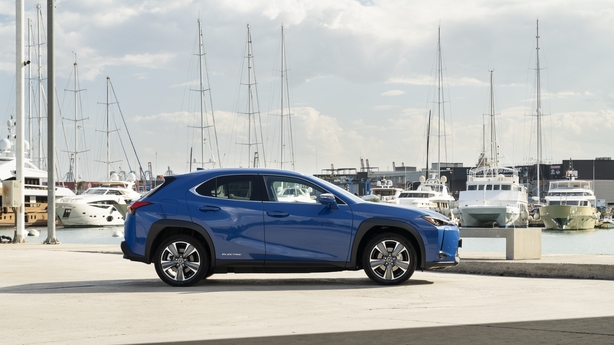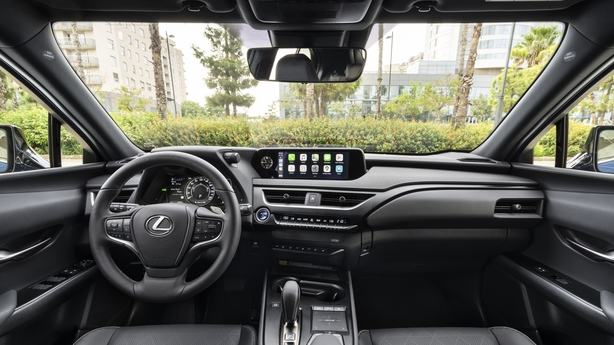Lexus describes its first electric car, the UX 300, as a car optimised for urban driving, which just about sums up the car's rather limited capacity.
As a small SUV-type vehicle, the UX 300 makes an impressive styling statement with its sculpted lines, large grille, narrow LED headlights and sweeping side profile. It's not a dramatic road presence though - its slightly conservative overall profile lets it stand out, but only just.
It's the smallest of the Lexus range but, crucially, it's the first all-electric car from Lexus and surely a portend of what is to come from Toyota when it finally embraces a fully-electric line-up. The car has been designed on a specially developed platform to accommodate battery electric engineering, which tends to take up interior space and adds significant weight to a car. In the case of the UX the rear passenger space has been compromised by the battery running beneath it and the boot is fairly limited to accommodating enough luggage for two or an average amount of shopping. You'll need to be slight of frame to get comfortable in the back of this car. The coupe style roofline doesn't help either, with the slope limiting headroom.
There are other limitations up front. The driver's seat travel doesn't accommodate taller people and you're limited in how you can adjust the steering wheel setting in front of you. Nor do you have the extra height off the ground that you get with a Volvo XC 40.

The battery of the UX will manage a very reasonable 0 to 100 KPH time of 7.5 seconds but the range is a fairly limited 300 km. After a mixed test drive of motorway and city routes it became clear that this is a car that is really designed for city driving. In town, the car will consume electricity in tandem with the mileage driven. In other words, the range will broadly match the available range in kilometres unless you're pushing hard on the accelerator.
On the motorway, it's a different story. For example, after driving on the motorway for 153 kilometres, the remaining available range was 79 kilometres. So, after setting out on a full charge, the range was 232 kilometres. Travelling at normal motorway speeds therefore had consumed an extra 68 kilometres. That's not going to amount to great peace of mind on a long journey, so you should be prepared for charging breaks. Two cars I can think of that offer much greater distances are the Volkswagen ID4 (with the largest battery) and the Skoda Enyaq, with both managing over 400 kilometres.
It's also worth noting that the Lexus uses a CVT gear system that is different in that it uses one gear that constantly adjusts itself, instead of a multi-gear automatic gearbox as you will find in a BMW or Mercedes. It's not the smoothest system and, while the familiar CVT whine may have been reduced, you will still feel the power output coming under pressure when climbing a hill, for example.
Lexus' own description of the UX as being "optimised for urban driving" pretty much sums up its offering here. It's not a long-distance runner.
The interior of the car is well designed in most respects, as one would expect of Lexus. Leather seats and a well finished look add to a sense of luxury.

There are, however, two ongoing problems that one would have expected Lexus to have sorted out by now. The touchpad - the same as one the you use on a laptop - that controls various functions is over-sensitive, distracting and frustrating to use. Given that most cars are left-hand drive and the driver would be using this pad beside the gearshift with their right hand may make some sense but it simply does'nt work the other way around. There were times when simply gave up using it, such was the level of irritation.
The display screen sizes - at 7" - are smaller and their resolution lower than many competitors. I've seen bigger and clearer screens on Skoda cars and the screen in Hyundai's new Tuscon leaves this one in the shade.
The UX does benefit from an excellent safety package. It has active cruise control, pre-collision sensors, steering assist, lane assist, road sign recognition and automatic LED headlight beam adjustment as standard and among other safety features.
There are premium features too. You can cool the interior of the car or set the heating system remotely by using an app. You will also get a ten year battery guarantee and Lexus has managed to reduce the effect of winter conditions on battery consumption by placing heating elements under the battery modules. Winter driving has a significant impact on battery consumption, when things like the radio, demister, heating and lights are all being used. It's not something other car manufacturers refer to very often when they are promoting their battery vehicles.
At €56,550 the UX doesn't come cheap but Lexus cars don't come cheap. However, this a premium price for a city car.


